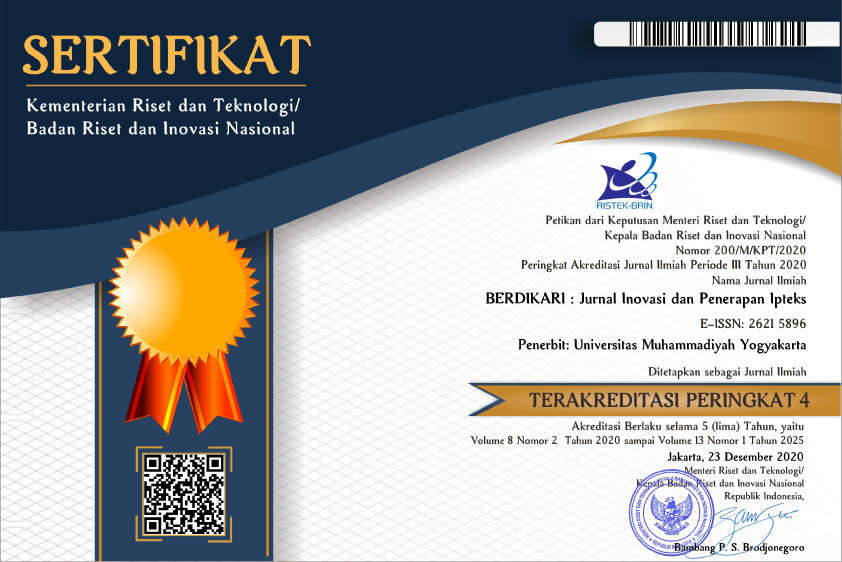Pemeriksaan dan Edukasi Gangguan Pendengaran Pada Anak Panti Asuhan
Abstract
Unhealthy ears may cause hearing loss. This issue may affect children to have difficulty communicating with others and decrease learning achievement at school. This community service activity aimed to give knowledge about hearing loss and conduct hearing examinations in orphanage children. This community service was held at the Aulia Al-Ikhlas Orphanage in Sungai Pagar Village, Kampar Kiri Hilir District, Kampar Regency, Riau. At the beginning of the activity, we provided counseling about hearing loss, followed by ear and hearing examinations using a tuning fork. Before and after the counseling, respondents filled out a questionnaire to assess knowledge about hearing loss. Twenty-four residents of the orphanage attended this activity. The questionnaires found that children's knowledge about hearing loss and ear health increased significantly after the counseling. The examination results found cerumen in 14 children, 4 with conductive hearing loss and 2 with sensory neural hearing loss. As a result, this community service activity can increase the knowledge of orphanage children about hearing loss and make their ears cleaner and healthier.
Keywords
Full Text:
PDFReferences
ASHA. (2018). Hearing loss. https://www.asha.org/public/hearing/Hearing-Loss/
Hamzah NF, Tajuddin A. (2021). The Effect of Earphone Use Behavior on Ear Disorders in Students University of Muhammadiyah Makassar, 2020. Al-Iqra Medical Journal, 17.
Kementerian Kesehatan Republik Indonesia. (2010). Telinga sehat pendengaran baik. https://www.kemkes.go.id/article/view/840/telinga-sehat-pendengaran-baik.html
Kementrian Kesehatan Republik Indonesia. (2016). Direkorat Jenderal Penyakit Tidak Menular. Profil Penyakit Tidak Menular.
http://p2ptm.kemkes.go.id/dokumen-ptm/profil-penyakit-tidak-menular-tahun-2016
Kolegium Ilmu Kesehatan THT. Modul THT Komunitas. Gangguan Pendengaran pada Anak Usia Sekolah. Edisi 1. Jakarta: Kolegium Ilmu Kesehatan THT-KL;2008.
Laoh A, Rumampuk JF, Lintong F. (2015). Hubungan penggunaan headset terhadap fungsi pendengaran pada mahasiswa angkatan 2012 Fakultas Kedokteran Universitas Sam Ratulangi. Jurnal Kedokteran Komunitas dan Tropik;3(3):142-147.
Martini, E., Probandari, A., Pratiwi, D., & Sumardiyono. (2017). Skrining dan Edukasi Gangguan Pendengaran pada Anak Sekolah. Indonesian Journal On Medical Science, 4(1), 110–118. https://ejournal.ijmsbm.org/index.php/ijms/article/view/103
Novita I, Rahayu MS. (2015). Hubungan perilaku penggunaan alat dengar telinga dengan gangguan pendengaran pada mahasiswa program studi pendidikan dokter. Lentera;15(13):23-28.
Soetirto I, Hendarmin H, Bashiruddin J. (2012). Gangguan Pendengaran (Tuli). Dalam: Soepardi EA, Iskandar N, Bashiruddin J, Restuti RD (Eds.), Buku Ajar Ilmu Kesehatan Telinga Hidung Tenggorok Kepala & Leher. Edisi ketujuh. Jakarta: Fakultas Kedokteran Universitas Indonesia.
Susiyanti E, Imanto M. Efek penggunaan earphone sebagai faktor resiko kejadian noise induced hearing loss. Majority 2020;9(2):63-67.
WHO. (2021). World Report on Hearing. In World Health Organization. https://www.who.int/publications/i/item/world-report-on-hearing
DOI: https://doi.org/10.18196/berdikari.v11i1.16639
Refbacks
- There are currently no refbacks.

This work is licensed under a Creative Commons Attribution 4.0 International License.
__________________________________________________________________
Contact us: BERDIKARI : Jurnal Inovasi dan Penerapan Ipteks, Address: Gedung D, LP3M UMY, Alamat: Jl. Brawijaya, Tamantirto, Kec. Kasihan, Bantul, Daerah Istimewa Yogyakarta 55183. Email: berdikari@umy.ac.id

Ciptaan disebarluaskan di bawah Lisensi Creative Commons Atribusi 4.0 Internasional.



